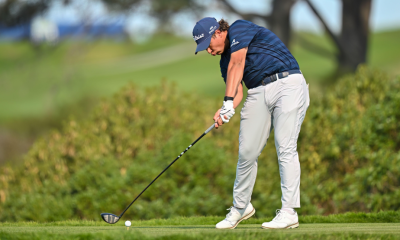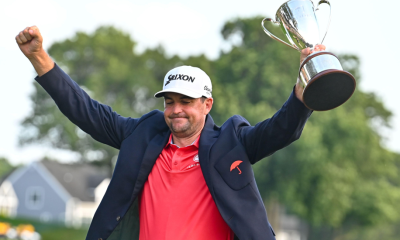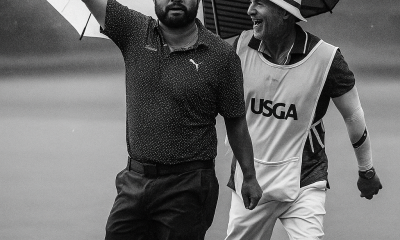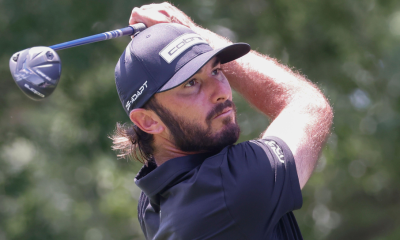Opinion & Analysis
Overrated? That’s not what the stats say about Rickie Fowler
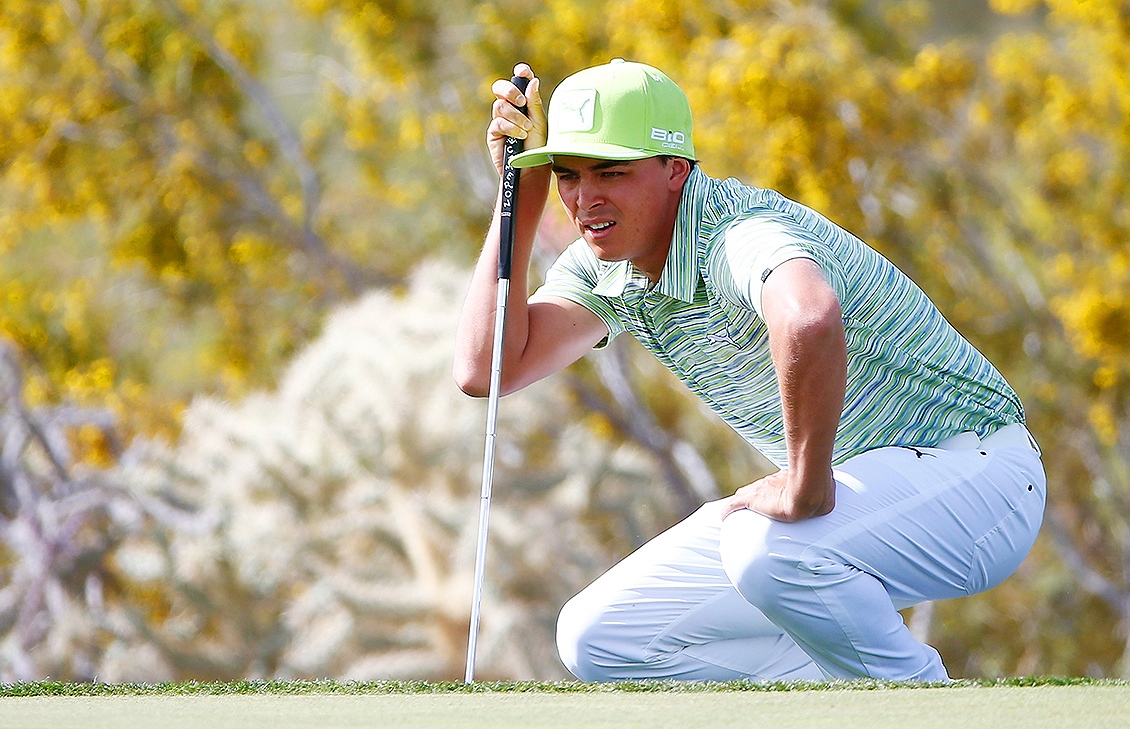
One of the most publicized swing changes this season has been Rickie Fowler’s decision to alter some of his swing mechanics with instructor Butch Harmon.
Fowler had his first career victory in 2012 and finished 40th on the 2013 Money List. Since he began making swing changes with Harmon in December, however, he has missed the cut in three of five events. But Fowler played terrific in his most recent tournament, the WGC-Accenture Match Play Championship, where he finished third. And when I look at Fowler’s metrics, the projections show him playing more like he did at the Accenture Match play than in his previous four events.
First, let’s take a look at Fowler’s rankings in the key scoring metrics in 2013. These rankings are based out of 180 players.
Typically, the ranking in Adjusted Scoring Average and Money List ranking tend to be very similar. If they are a bit off, then the Money List Ranking tends to eventually match the Adjusted Scoring Average ranking. In this case, Fowler’s Adjusted Scoring Average ranking is noticeably worse (67th) than his Money List ranking (40th). This is because Fowler ranked 20th in purse size per event. He was playing in more lucrative events and that allowed him to rank higher in earnings than his Adjusted Scoring Average indicated. However, Fowler had good reason to be concerned since his play in 2013 ran the risk of not being good enough to qualify him for the more lucrative events he was able to play in 2013.
With that said, Fowler’s rankings are pretty solid. Par-4 play is the most important metric, and he performed well on par-4’s in 2013. He also was in the top-10th percentile on the par-5’s. Even his Bogey Rate and Birdie Rate are pretty good. However, he was one of the leaders in double bogeys last year, which is what the bogey rate metric does not quite show. So every time he made a double bogey, he now had to make two birdies in order to break even. Lastly, if he wants to get to an elite status as a golfer, he needs to get into the top-10th percentile in par-4 play and Bogey Rate.
Here are Fowler’s rankings in the key performance metrics in 2013
These metrics are not overly impressive, but not poor either. And he was very good at the two parts of the game that correlate most to success on Tour: Danger Zone play and Putts Gained.
When we consider his trouble with double bogeys, I normally take a look at his driving and some key precision metrics:
Again, Fowler was not great at these metrics, but he was not poor by Tour standards either. The Missed Fairway – Other % is essentially any tee shot that finds a hazard, O.B. or results in a rescue shot, and he was still better than the Tour average there. However, I did find something very peculiar about his driving with his radar metrics.
Generally, a golfer’s driving distance ranking and club head speed ranking should come close to matching. If there is a large discrepancy, it is usually due to the golfer hitting upward or downward on the ball. In Fowler’s case, his driving distance is far less than his club head speed ranking. This would indicate that he is hitting down on the ball too much. However, his launch angle and Max Height indicate that he likes to hit up on the ball. Meanwhile, his high spin rate is more indicative a downward attack angle.
So, which is it?
Fowler ranked 55th in Ball Speed and given his ranking in club head speed it indicates that he was making quality strikes with his driver as his smash factor was rather high. I think he probably was hitting up a little on the driver and he was ill-fitted from an equipment standpoint. This would cause the ball to balloon, which would explain his high Max Height and it would come down with a lot of spin so he was not getting any roll. And this was causing Fowler to lose one of his strengths, in his ability to hit the ball far.
Still, I do not see the driving as the major culprit for his double bogey woes. He simply did not miss big off the tee frequently. Instead, I think he had a major problem from the Safe Zone (125-to-175 yards) as he was putting himself in pretty good position off the tee, but only ranked 102nd from that distance. Most of the high birdie makers that are not ‘Bubba-long’ tend to play very well from the Safe Zone and Fowler’s below average play also cost him some birdies. In the end, I could see why Fowler was looking for a new perspective. His game was slipping a little and he probably did not want to have to change too much when it was too late.
Here are his key performance metrics for the 2013-2014 season (out of 174 players):
Fowler’s iron play has improved quite dramatically. While he is slightly worse from the Danger Zone, the important metric to keep in mind is shots from the fairway as that is the greatest indicator of a Tour player’s pure iron skill. Fowler ranked 91st in the metric in 2013 and is now the best from the fairway on Tour. So if his Danger Zone play has dropped slightly, it is more due to him hitting a few more shots from the rough.
And while the driving effectiveness is roughly the same, the key radar metrics indicate that it will get better.
Fowler is not only hitting the ball farther, but he is generating more club head speed. And his driving distance ranking and club head speed ranking match. The other radar metrics are virtually the same except that his spin rate has lowered by about 450 rpm. He has regained his advantage of hitting the ball a long ways and his iron play has greatly improved.
The only thing that has hampered Fowler is his putting, as he currently ranks last in Putts Gained. Here are his rankings in Putts Gained each year since turning pro:
Fowler has been a pretty good putter on Tour throughout his career. I feel that he is on the right path with his ball striking to get to that next level of winning a major. He has regained his power with his driving and has been striking his irons at an elite level. His short game has been sound and the only thing lacking has been his putting, which has probably suffered due to him focusing more of his attention on his swing.
I have my doubts about him contending in the majors this year. But, if he can continue to improve at this rate with his irons, fine tune his driving and get his putting back, Fowler could have a breakout year in 2015.
Opinion & Analysis
The 2 primary challenges golf equipment companies face

As the editor-in-chief of this website and an observer of the GolfWRX forums and other online golf equipment discourse for over a decade, I’m pretty well attuned to the grunts and grumbles of a significant portion of the golf equipment purchasing spectrum. And before you accuse me of lording above all in some digital ivory tower, I’d like to offer that I worked at golf courses (public and private) for years prior to picking up my pen, so I’m well-versed in the non-degenerate golf equipment consumers out there. I touched (green)grass (retail)!
Complaints about the ills of and related to the OEMs usually follow some version of: Product cycles are too short for real innovation, tour equipment isn’t the same as retail (which is largely not true, by the way), too much is invested in marketing and not enough in R&D, top staffer X hasn’t even put the new driver in play, so it’s obviously not superior to the previous generation, prices are too high, and on and on.
Without digging into the merits of any of these claims, which I believe are mostly red herrings, I’d like to bring into view of our rangefinder what I believe to be the two primary difficulties golf equipment companies face.
One: As Terry Koehler, back when he was the CEO of Ben Hogan, told me at the time of the Ft Worth irons launch, if you can’t regularly hit the golf ball in a coin-sized area in the middle of the face, there’s not a ton that iron technology can do for you. Now, this is less true now with respect to irons than when he said it, and is less and less true by degrees as the clubs get larger (utilities, fairways, hybrids, drivers), but there remains a great deal of golf equipment truth in that statement. Think about it — which is to say, in TL;DR fashion, get lessons from a qualified instructor who will teach you about the fundamentals of repeatable impact and how the golf swing works, not just offer band-aid fixes. If you can’t repeatably deliver the golf club to the golf ball in something resembling the manner it was designed for, how can you expect to be getting the most out of the club — put another way, the maximum value from your investment?
Similarly, game improvement equipment can only improve your game if you game it. In other words, get fit for the clubs you ought to be playing rather than filling the bag with the ones you wish you could hit or used to be able to hit. Of course, don’t do this if you don’t care about performance and just want to hit a forged blade while playing off an 18 handicap. That’s absolutely fine. There were plenty of members in clubs back in the day playing Hogan Apex or Mizuno MP-32 irons who had no business doing so from a ballstriking standpoint, but they enjoyed their look, feel, and complementary qualities to their Gatsby hats and cashmere sweaters. Do what brings you a measure of joy in this maddening game.
Now, the second issue. This is not a plea for non-conforming equipment; rather, it is a statement of fact. USGA/R&A limits on every facet of golf equipment are detrimental to golf equipment manufacturers. Sure, you know this, but do you think about it as it applies to almost every element of equipment? A 500cc driver would be inherently more forgiving than a 460cc, as one with a COR measurement in excess of 0.83. 50-inch shafts. Box grooves. And on and on.
Would fewer regulations be objectively bad for the game? Would this erode its soul? Fortunately, that’s beside the point of this exercise, which is merely to point out the facts. The fact, in this case, is that equipment restrictions and regulations are the slaughterbench of an abundance of innovation in the golf equipment space. Is this for the best? Well, now I’ve asked the question twice and might as well give a partial response, I guess my answer to that would be, “It depends on what type of golf you’re playing and who you’re playing it with.”
For my part, I don’t mind embarrassing myself with vintage blades and persimmons chasing after the quasi-spiritual elevation of a well-struck shot, but that’s just me. Plenty of folks don’t give a damn if their grooves are conforming. Plenty of folks think the folks in Liberty Corner ought to add a prison to the museum for such offences. And those are just a few of the considerations for the amateur game — which doesn’t get inside the gallery ropes of the pro game…
Different strokes in the game of golf, in my humble opinion.
Anyway, I believe equipment company engineers are genuinely trying to build better equipment year over year. The marketing departments are trying to find ways to make this equipment appeal to the broadest segment of the golf market possible. All of this against (1) the backdrop of — at least for now — firm product cycles. And golfers who, with their ~15 average handicap (men), for the most part, are not striping the golf ball like Tiger in his prime and seem to have less and less time year over year to practice and improve. (2) Regulations that massively restrict what they’re able to do…
That’s the landscape as I see it and the real headwinds for golf equipment companies. No doubt, there’s more I haven’t considered, but I think the previous is a better — and better faith — point of departure when formulating any serious commentary on the golf equipment world than some of the more cynical and conspiratorial takes I hear.
Agree? Disagree? Think I’m worthy of an Adam Hadwin-esque security guard tackle? Let me know in the comments.
@golfoncbs The infamous Adam Hadwin tackle ? #golf #fyp #canada #pgatour #adamhadwin ? Ghibli-style nostalgic waltz – MaSssuguMusic
Podcasts
Fore Love of Golf: Introducing a new club concept

Episode #16 brings us Cliff McKinney. Cliff is the founder of Old Charlie Golf Club, a new club, and concept, to be built in the Florida panhandle. The model is quite interesting and aims to make great, private golf more affordable. We hope you enjoy the show!
Opinion & Analysis
On Scottie Scheffler wondering ‘What’s the point of winning?’

Last week, I came across a reel from BBC Sport on Instagram featuring Scottie Scheffler speaking to the media ahead of The Open at Royal Portrush. In it, he shared that he often wonders what the point is of wanting to win tournaments so badly — especially when he knows, deep down, that it doesn’t lead to a truly fulfilling life.
View this post on Instagram
“Is it great to be able to win tournaments and to accomplish the things I have in the game of golf? Yeah, it brings tears to my eyes just to think about it because I’ve literally worked my entire life to be good at this sport,” Scheffler said. “To have that kind of sense of accomplishment, I think, is a pretty cool feeling. To get to live out your dreams is very special, but at the end of the day, I’m not out here to inspire the next generation of golfers. I’m not out here to inspire someone to be the best player in the world, because what’s the point?”
Ironically — or perhaps perfectly — he went on to win the claret jug.
That question — what’s the point of winning? — cuts straight to the heart of the human journey.
As someone who’s spent over two decades in the trenches of professional golf, and in deep study of the mental, emotional, and spiritual dimensions of the game, I see Scottie’s inner conflict as a sign of soul evolution in motion.
I came to golf late. I wasn’t a junior standout or college All-American. At 27, I left a steady corporate job to see if I could be on the PGA Tour starting as a 14-handicap, average-length hitter. Over the years, my journey has been defined less by trophies and more by the relentless effort to navigate the deeply inequitable and gated system of professional golf — an effort that ultimately turned inward and helped me evolve as both a golfer and a person.
One perspective that helped me make sense of this inner dissonance around competition and our culture’s tendency to overvalue winning is the idea of soul evolution.
The University of Virginia’s Division of Perceptual Studies has done extensive research on reincarnation, and Netflix’s Surviving Death (Episode 6) explores the topic, too. Whether you take it literally or metaphorically, the idea that we’re on a long arc of growth — from beginner to sage elder — offers a profound perspective.
If you accept the premise literally, then terms like “young soul” and “old soul” start to hold meaning. However, even if we set the word “soul” aside, it’s easy to see that different levels of life experience produce different worldviews.
Newer souls — or people in earlier stages of their development — may be curious and kind but still lack discernment or depth. There is a naivety, and they don’t yet question as deeply, tending to see things in black and white, partly because certainty feels safer than confronting the unknown.
As we gain more experience, we begin to experiment. We test limits. We chase extreme external goals — sometimes at the expense of health, relationships, or inner peace — still operating from hunger, ambition, and the fragility of the ego.
It’s a necessary stage, but often a turbulent and unfulfilling one.
David Duval fell off the map after reaching World No. 1. Bubba Watson had his own “Is this it?” moment with his caddie, Ted Scott, after winning the Masters.
In Aaron Rodgers: Enigma, reflecting on his 2011 Super Bowl win, Rodgers said:
“Now I’ve accomplished the only thing that I really, really wanted to do in my life. Now what? I was like, ‘Did I aim at the wrong thing? Did I spend too much time thinking about stuff that ultimately doesn’t give you true happiness?’”
Jim Carrey once said, “I think everybody should get rich and famous and do everything they ever dreamed of so they can see that it’s not the answer.”
Eventually, though, something shifts.
We begin to see in shades of gray. Winning, dominating, accumulating—these pursuits lose their shine. The rewards feel more fleeting. Living in a constant state of fight-or-flight makes us feel alive, yes, but not happy and joyful.
Compassion begins to replace ambition. Love, presence, and gratitude become more fulfilling than status, profits, or trophies. We crave balance over burnout. Collaboration over competition. Meaning over metrics.
Interestingly, if we zoom out, we can apply this same model to nations and cultures. Countries, like people, have a collective “soul stage” made up of the individuals within them.
Take the United States, for example. I’d place it as a mid-level soul: highly competitive and deeply driven, but still learning emotional maturity. Still uncomfortable with nuance. Still believing that more is always better. Despite its global wins, the U.S. currently ranks just 23rd in happiness (as of 2025). You might liken it to a gifted teenager—bold, eager, and ambitious, but angsty and still figuring out how to live well and in balance. As much as a parent wants to protect their child, sometimes the child has to make their own mistakes to truly grow.
So when Scottie Scheffler wonders what the point of winning is, I don’t see someone losing strength.
I see someone evolving.
He’s beginning to look beyond the leaderboard. Beyond metrics of success that carry a lower vibration. And yet, in a poetic twist, Scheffler did go on to win The Open. But that only reinforces the point: even at the pinnacle, the question remains. And if more of us in the golf and sports world — and in U.S. culture at large — started asking similar questions, we might discover that the more meaningful trophy isn’t about accumulating or beating others at all costs.
It’s about awakening and evolving to something more than winning could ever promise.











